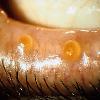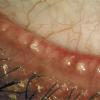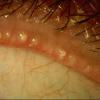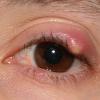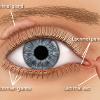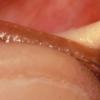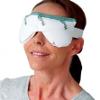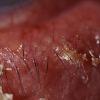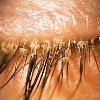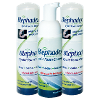Orthokeratology


|
Grading_Scales_web.pdf Size : 400.524 Kb Type : pdf |
UV Damage
Pinguecula
this picture is borrowed from: http://upload.wikimedia.org/
wikipedia/commons/5/53/PREOPERATIVE_
PINGUECULA.JPG
Pingueculitis (inflamed pinguecula)

this picture is borrowed from: http://webeye.ophth.uiowa.edu/eyeforum/atlas/
pages/pingueculitis-succulent-pinguecula.html
Pterygium

this picture is borrowed from: http://melbourneeyecentre.com.au/prod/wp-content/uploads/2013/04/pterygium-600x357.png
The American Optometric Association (AOA) recommends the use of sunglasses that block 99-100 percent of UV-A and UV-B rays to protect the eyes from this radiation. However, many sunglasses styles do not protect the eyes from the solar radiation entering from the sides or around sunglasses.
Some contact lenses offer additional protection. These contact lenses absorb UV radiation by reducing the amount of radiation that reaches the surface of eye. The contact lenses also protect the eye from the radiation that comes from above or around the sides of sunglasses.
The U.S. Food and Drug Administration (FDA) has standards for UV-blocking contact lenses based on American National Standards Institute Z80.20 standards. There are two classifications of UV-blocking lenses:
- FDA Class I blocker. recommended for high exposure environments such as mountains or beaches. The lenses in this classification must block more than:
- 90% of UVA (316-380 nm wavelengths) and
- 99% of UVB (280 – 315 nm)
- FDA Class II blocker. recommended for general purposes. These lenses must block more than:
- 70% of UVA and
- 95% of UVB
People who wear contact lenses and do not wear wrap-style sunglasses can further protect themselves from UV radiation by wearing contact lenses that block UV.
Cataract

this picture is borrowed from: http://www.mayoclinic.com/images/
image_popup/vi7_cataract.jpg

this picture is borrowed from: https://www.mesvision.com/images/tips_cataracts-diagram.jpg

Cataracts can be caused by numerous different factors. The most common cause is simply age, as it is a natural progression that occurs during your life as the lens inside your eye slowly becomes a bit hazy and discoloured with haze. Therefore, looking through a cataract can become a bit like looking through a dirty wind screen.

Meibomian Gland Dysfunction
Anterior Blepharitis
Glaucoma
Macular Degeneration
AMD calculator: http://caseyamdcalc.ohsu.edu/
Vitreo-Macular Traction



Dry Eyes
Contact Lens Related Issues
CHRPE - Congenital Hypertrophic Retinal Pigment Epithelium (NORMAL)
All images are sourced straight from the first page of results off Google Images. I do not own any of these images, and have put these pictures together solely for educational purposes in private use during consultations, not for public viewing.


